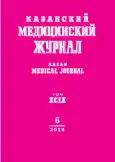Evaluation of clinical efficacy of prostanoid therapy for Raynaud’s phenomenon in rheumatic diseases
- Authors: Bagautdinova ZR1, Gaisin IR2, Glavatskikh MM2,3, Bragina TA1
-
Affiliations:
- Republican Clinical Diagnostic Centre
- Izhevsk State Medical Academy
- Udmurt State University
- Issue: Vol 99, No 6 (2018)
- Pages: 911-918
- Section: Theoretical and clinical medicine
- URL: https://journal-vniispk.ru/kazanmedj/article/view/10505
- DOI: https://doi.org/10.17816/KMJ2018-911
- ID: 10505
Cite item
Full Text
Abstract
Aim. On the basis of clinical manifestations of Raynaud’s phenomenon (RP) to determine the RP expression level and to evaluate the long-term efficacy of treatment of RP in patients with rheumatic diseases (RD) with iloprost and alprostadil.
Methods. Treatment for indications with prostanoids (intravenous iloprost, alprostadil or their combinations) was administered to 40 patients with secondary RP in RD. During 3-year follow up, clinical instrumental parameters (frequency of attacks of Raynaud's, digital ulcers (DU) formation, pain intensity on visual analogue scale (VAS) were evaluated. The control group included 30 patients with RP in RD who did not receive prostanoid therapy. The method of factor analysis was used to determine the index of generalized expression of RP, on the basis of which the expression levels of the RP were determined.
Results. The “expression of RP” scale revealed in the course of factor analysis as an indicator of generalized manifestation of RP, is the average value of two subscales, the first one of which consisted of four indices - “digital ulcer”, “digital pitting scars”, “phalange amputation” and “Raynaud's attack frequency”, and the second one included “intensity of pain”, “duration of illness”, “whitening of fingers”. Verification of the correlation revealed during the study of subscales, showed its reliability (r = 0.294, p = 0.053). The final expression of RP was 1.51 ± 0.86. The low level of RP expression had values up to 0.65, high - over 2.37. When included in the study, a high level of RP expression was defined in 16 (22.9 %) patients, medium - in 43 (61.4 %), low - in 11 (15.7 %). The use of iloprost in the treatment of RP was effective for healing of DU and a statistically significant decrease of the generalized expression of RP from 2.25 [1; 3] to 1.75 [1; 2] (p = 0.012) was observed. On alprostadil treatment, statistically significantly decreased frequency of attacks from multiple daily (more than once a day) to once a month and reduced numbness during RP attack were observed as well as a decrease of the level of generalized index of RP expression from 1.26 ± 0.71 to 0.97 ± 0.57 (р = 0.038). The combination of prostanoids had a contradictory clinical effect: the pain and frequency of RP attacks decreased, but the formation of DU and new cases of amputations of phalanges were registered, the treatment had no effect on the value of RP expression.
Conclusion. Based on the clinical manifestations of RP, a generalized index of RP severity was identified and the levels of RP severity were determined. Treatment with iloprost and alprostadil has a significant effect on reducing the clinical manifestations of RP with a corresponding decrease in its severity.
Full Text
##article.viewOnOriginalSite##About the authors
Z R Bagautdinova
Republican Clinical Diagnostic Centre
Author for correspondence.
Email: zukhra.bagautdinova@yandex.ru
Izhevsk, Russia
I R Gaisin
Izhevsk State Medical Academy
Email: zukhra.bagautdinova@yandex.ru
Izhevsk, Russia
M M Glavatskikh
Izhevsk State Medical Academy; Udmurt State University
Email: zukhra.bagautdinova@yandex.ru
Izhevsk, Russia; Izhevsk, Russia
T A Bragina
Republican Clinical Diagnostic Centre
Email: zukhra.bagautdinova@yandex.ru
Izhevsk, Russia
References
- Alekperov R.T. Raynaud’s syndrome as a multidisciplinary problem. Al’manakh klinicheskoy meditsiny. 2014; 35: 94–100. (In Russ.)
- Prete M., Fatone M.C., Favoino E., et al. Raynaud’s phenomenon: from molecular pathogenesis to therapy. Autoimmun. Rev. 2014; 13: 655–667. DOI: 10.1016/
- j.autrev.2013.12.001.
- Merkel P., Herlyn K., Martin R., et al. Measuring disease activity and functional status in patients with scleroderma and Raynaud’s phenomenon. Arthritis Rheum. 2002; 9: 2410–2420. doi: 10.1002/art.10486.
- Silva I., Almedia J., Vasconcelos C. A PRISMA-driven systematic review for predictive risk factors of digital ulcers in systemic sclerosis patients. Autoimmun. Rev. 2015; 14 (2): 140–152. doi: 10.1016/j.autrev.2014.10.009.
- Baumhäkel M., Böhm M. Recent achievements in the management of Raynaud’s phenomenon. Vasc. Health Risk Manag. 2010; 6: 207–214. doi: 10.2147/VHRM.S5255.
- Hughes M., Herrick A.L. Digital ulcers in systemic sclerosis. Rheumatology (Oxford). 2017; 56 (1): 14–25. doi: 10.1093/rheumatology/kew047.
- Kowal-Bielecka O., Fransen J., Avouac J., et al. Update of EULAR recommendation for the treatment of systemic sclerosis. Ann. Rheum. Dis. 2017; 76 (8): 1327–1339. doi: 10.1136/annrheumdis-2016-209909.
- Rossiyskie klinicheskie rekomendatsii. Revmatologiya. (Russian clinical recommendations. Rheumatology.) Ed. by E.L. Nasonov. Moscow: GEOTAR-Media 2017; 150–151. (In Russ.)
- Anan’eva L.P. Treatment of systemic sclerosis in accordance with national guidelines and recommendations of the European League against Rheumatism (EULAR). Farmateka. 2014; 10: 79–86. (In Russ.)
- Guseva N. Vazaprostan in treatment of systemic scleroderma and Raynaud’s syndrome. Doctor. 2006; 5: 46–50. (In Russ.)
- Levien T.L. Advances in the treatment of Raynaud’s phenomenon. Vascular Health and Risk Management. 2010; 6: 167–177. doi: 10.2147/VHRM.S4551.
- Tingey Th., Shu J., Smuczek J., Pope J. Meta-analysis of healing and prevention of digital ulcers in systemic sclerosis. Arthritis Care & Research. 2013; 65 (9): 1460–1471. doi: 10.1002/acr.22018.
Supplementary files






